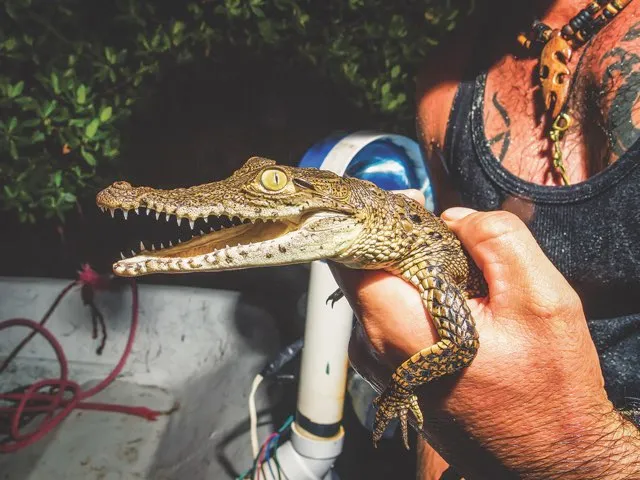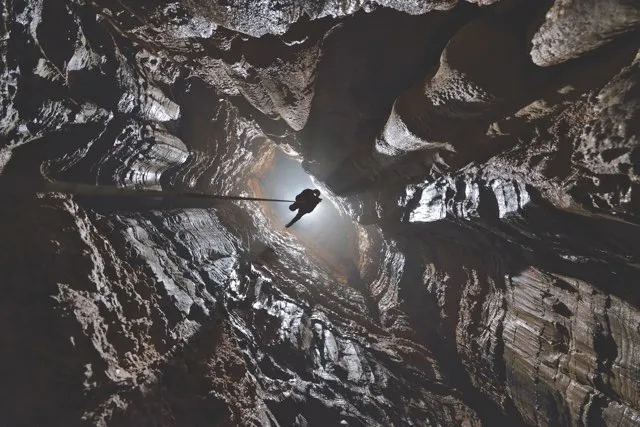The Lava Lover
I first became interested in volcanoes when I was about seven. I slept with a volcano picture book under my pillow.
There have been concerning moments. One night in Chile, heavy ash and pumice rained down on our camp and we had to decide whether to stay or go. Or there was the time we were digging increasingly desperately into the mountainside to find uncontaminated snow to melt for drinking water.
I also spent months camping in Iceland for my PhD, enduring days of wind and rain. It’s not much fun putting on wet clothes for the fourth day in a row, but the exquisite beauty and isolation of the environment makes up for it.
I study what makesvolcanoesexplosive and how the gas trapped in magma drives violent eruptions, forcing out lava and throwing ash kilometres into the air. We’re also trying to figure out what controls the way that lava flows, in the hope of helping people who live in its path. This means travelling abroad to erupting volcanoes, often at short notice, to witness these explosions.
Sometimes it’s possible to walk up to lava as it flows and take samples with a shovel. Back in the lab, we’ll heat a sample to over 1,200°C so it’ll behave like it’s in the volcano. This means we can see what’s happening on a microscopic scale.
Knowing that my work can help lots of people is motivating. But it’s annoying that there are far too many interesting volcanoes to study, and that’s before you even include the ones on other planets and moons in our Solar System.
Read more:
The Croc Psychologist

NAME: Cherie Chenot-Rose
JOB TITLE: Research biologist and co-founder of American Crocodile Education Sanctuary
BASED: Florida and Belize
I’ve been bitten by three species of crocodilians, and one broke my shin with a whip of its head. I don’t carry a weapon but my teammates have large knives. Our intent is not to harm the animal, and we never have, but human safety always comes first.
We normally get called out when a crocodile is under someone’s home. We wait through the night, wet, muddy and stinking of rotten chicken, which we use to tempt the crocodile out. Then, game on! My husband, Vince, snares the croc and drags it onto land while I position myself behind it. When the time is right, I leap onto the head of the animal. An assistant secures the back legs, then we tie up the croc, collect data and tag it before releasing it. If people’s safety is at risk, we relocate the croc, or place it into captivity.
To know how to respond, we need to study the behaviour of the animals. The crocodile to worry about it is the one at the water’s edge, totally submerged but for the tip of its nose, watching you through its translucent third eyelid. While you are distracted, it’s waiting for the right moment to strike.
A croc can strike three times faster than a rattlesnake.
One time, while capturing a three-metre male crocodile, the rope broke. I felt the vibration from its teeth smashing together just inches from my upper thigh. Crocodiles smack their jaws together so hard that they can shatter their own teeth.
The toughest part is not capturing the crocodiles, it’s obtaining funding. The most rewarding part of my job is rescuing an injured crocodile, rehabilitating it and setting it free.
Read more:
The Gut Detective
NAME: Dr Enid Taylor
JOB TITLE: Clinical director of the Taymount Clinic for Digestive Health
BASED: Hertfordshire, UK
The first time a caller asked if we did faecal transplants, I was so horrified I cleaned the phone in disdain. Back then, the Taymount was a naturopathy clinic, but my husband, Glenn, had a light bulb moment – he saw faecal microbiota transplant (FMT) as the answer to a huge problem, and the FMT clinic evolved from there. We now use FMT to treat patients with various gut conditions.
We extract good bacteria from donor stool and refine it. We wear protective clothing as nobody wants to be splashed in poo, refined or not! Early in our equipment development, a tube blew out of a lid and a jet of liquid faecal material shot into the ceiling extractor. We had to laugh as the s**t really had hit the fan!
Once we’ve refined the donation, we ultra deep-freeze it. When it’s ready to be used, it is thawed, warmed and introduced into the patient’s body using a rectal catheter. There’s little smell as it’s all contained within syringes. During administration, you have to be gentle; I get the patient to lie in relaxing positions and talk to them about diet and how to look after their new internal ‘pets’.
It’s a personal journey that brought me into this work. I had irritable bowel syndrome, and have always been interested in food and digestive health. When you painfully need the toilet every 45 minutes, it’s hard to keep a job and maintain relationships. Helping people regain normal function is heart-warming.
When people ask what I do, I take a deep breath and decide whether to give the short answer or the longer, more scientific one. Sometimes, I joke that I’m a ‘poo doctor’. My husband and I have five grown-up children. At first they didn’t know what we did, but now they ask advice. I have a sneaking suspicion they might be a little bit proud.
Read more:
- The British microbiome: how our guts can tell us more than our genes
- 15 tips to boost your gut microbiome
The Spider Milker

NAME: Steve Trim
JOB TITLE: Founder of Venomtech
BASED: Sandwich, UK
Keeping spiders and reptiles fascinates me.
I kept non-dangerous spiders and snakes as pets, but following redundancy, I used my previous experience working in pharmaceuticals to set up Venomtech in the back of a pet shop in Ramsgate. Six years on, we now occupy a large lab.
Venomtech is the UK’s only commercial venom supplier. We collect venom from: 70 species of theraphosidae, which is a family that includes tarantulas; 30 scorpion species; several true spiders such as black widows, brown recluses and Brazilian wandering spiders; jellyfish and anemones; centipedes; millipedes; some ground beetles; and 65 species of venomous snakes.
Clad in lab coats, gloves and safety glasses, we hold the snakes behind the head using a handling tool. They are happy to deliver venom into anything in front of them, including our polypropylene pots.
The toughest work is with small spiders such as black widows (the most toxic creature in our lab). Their fangs are so tiny, you need a steady hand, great discipline and a methodical approach. We place their fangs into little collection tubes and stimulate the venom glands with tiny electrical impulses. If the venom misses, it is unusable. Even anaesthetised, black widows are handled with forceps and given a constant flow of CO2 to ensure they stay asleep.
My family worries, but my wife shares my passion for venomous animals, and we have not had any incidents. The best part is seeing our venoms killing E. coli and Staphylococcus, which could help with antibiotic resistance.
Read more:
- What is the difference between poison and venom?
- The bite that cures: how we’re turning venom into medicine
The Insect Investigator
NAME: Dr Amoret Whitaker
JOB TITLE: Forensic entomologist
BASED: University of Winchester and the Natural History Museum, UK
The first time I looked at insects down a microscope at university, I thought they were amazing. I’d never really thought about insects before, as I wasn’t one of those kids who was collecting butterflies from an early age.
I began my zoology degree imagining I’d end up saving big, furry animals.
I study insects in a legal context, usually the flies and beetles that colonise dead bodies. It’s a mixture of research, where I study the development of flies and beetles in different conditions, and work with the police, where I use that knowledge to determine when a person died. Blowflies are usually the first insects to find a body, so they’re useful for estimating the time since death.
In this job you never know what’s going to happen. There are just a handful of forensic entomologists to cover the whole country, so I’m on call 24 hours a day, seven days a week. Sometimes I can be working on six cases, and other times I might go months without a call-out. I also teach at the University of Winchester, and do research at London’s Natural History Museum and the ‘body farm’ at the University of Tennessee, where corpses are left to decay and studied.
The case work can be distressing. And there are scary moments too, such as working on the body farm at night. It’s incredibly satisfying though, particularly helping bring closure to families. Unlike the three years that I spent studying fleas earlier in my career, no one ever asks me what the point of it is.
Read more:
- Is the first cut the deepest? What it’s like to dissect your first dead body
- Here's what happens when your dead body is left to rot (plus a few, more practical, uses for it)
The Cave Raider

NAME: Dr Hazel Barton
JOB TITLE: Microbiologist
BASED: University of Akron, Ohio
I started caving back in sixth form at school, long before I became a scientist. When I started working as an environmental microbiologist, it seemed natural to combine the two.
I study microbial ecosystems in deep and remote caves, trying to work out how microorganisms can grow in the dark with so few nutrients. We work at depths of up to 500m – the microbiology gets more interesting the deeper you get. We’ll spend around a week in a cave, exploring its structure and taking samples of microbes. The expeditions are huge undertakings, about as logistically technical as climbing Everest. We rig our own ropes, and carry all our camping gear and research equipment, sometimes through gaps as small as 20cm.
When you spend a week in complete darkness, you have to be careful that your circadian rhythm doesn’t slip into 27-hour days. I make sure that everyone’s in bed by 10pm and up at 7am. On the first few trips you get really cranky because of the lack of sunlight. And you need to make sure that you like and trust the people you’re with. If something goes wrong, your life is in their hands.
The best thing about my job is the travel – as well as the US, we also work in Venezuela, Brazil, Belgium and China. You never know what you’re going to find. In China, we discovered the third biggest cave room in the world by following a river into a mountainside and ending up in a vast space 600m long, 200m wide and 400m high. It was an incredible feeling.
- This article was first published in August 2016.
Follow Science Focus onTwitter,Facebook, Instagramand Flipboard
